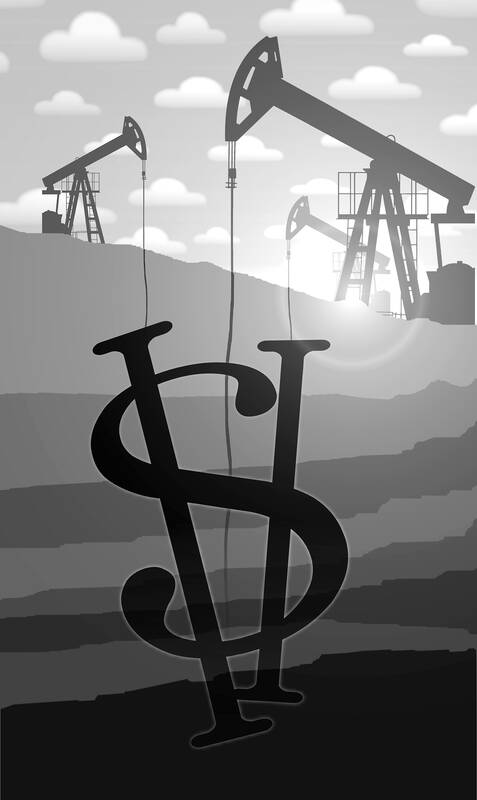Here is an economic truth that fossil fuel detractors rarely talk about: The US oil industry has done more to reduce its country’s trade deficit than any other. Thanks to geological luck, engineering prowess and shrewd capitalism, the shale revolution turned what two decades ago was a nearly US$400 billion-a-year oil trade deficit into a US$45 billion surplus last year. Now, US President Donald Trump, in theory the champion of “drill, baby, drill,” risks killing it.
The White House is pushing oil prices toward US$50 a barrel, and perhaps even lower if you believe — difficult as it is — what US trade czar Peter Navarro said. As oil prices plunged 17 percent in a week, US Secretary of the Treasury Scott Bessent was on television cheerleading the crash. Part of the decline is the collateral damage from the tariff drama of recent days, but the White House’s fingerprints are all over the other part: diplomatic pressure on OPEC+ to increase output. The Trump administration seems to be motivated by a desperate attempt to cushion the inflationary impact of the trade war with cheap oil.
Yet, US$50-a-barrel would have another macroeconomic consequence: widening the trade deficit that Trump wants to reduce. “Drill, baby, drill” does not work at US$50 a barrel — and if the US does not drill, it must import. On Wednesday, West Texas Intermediate touched a four-year low of US$55.12 a barrel, only to recover to about US$60 a barrel after Trump made a U-turn in the trade war.

Illustration: Yusha
Still, a lot of the damage is done. To understand what is at stake, it helps to go back to 2008, during the second term of then-US president George W. Bush. The US trade deficit was running then at about US$800 billion a year. Nearly half of that — US$386 billion, to be precise — corresponded to the imbalance in petroleum trade. The enormity of the petroleum trade deficit becomes clear if one thinks about it as a country. Measured as such, it was nearly as large as the US-China deficit has ever been. With domestic production dwindling, the country imported, on a net basis, more than 11 million barrels a day of crude and refined oil products. As Bush famously put it, the US was “addicted” to foreign oil.
Then came the shale revolution. US wildcatters spent years experimenting with ways to crack a new source of petroleum: shale formations. To the untrained eye, they look like a tiramisu, with thin layers of productive, but very hard-to-crack rock sandwiched between non-productive ones. By the mid-2000s, engineers had found a way to tap the riches: drill vertical wells several miles deep into the tiramisu and then turn the bit about 90° to proceed horizontally — nowadays as far as 6,000m. Those L-shaped wells reached deep into the productive stratum.
Then began the hydraulic fracturing, or fracking — water, sand and chemicals were blasted deep underground to free oil from the hard-to-crack shale rock. What followed was a gusher. US total oil production — including crude, condensates and other liquids — boomed, rising to 20.1 million barrels a day last year, up from 6.7 million in 2008. Alongside, oil imports collapsed. The 11 million barrels a day of net oil imports during the late Bush presidency turned into net exports of more than 2 million barrels a day by the time former US president Joe Biden left the White House.
The oil export boom reduced the overall trade deficit, created thousands of blue-collar jobs in Texas, North Dakota and other typically deprived areas of the US, and supported manufacturers. It helped that the OPEC cartel cut production to keep prices high, in effect subsidizing shale. Now, the US oil patch is getting a taste of what a free market looks like. It is difficult to feel a lot of sympathy for it. The sector got what it voted for: Trump won in Midland, the Texas town that is the capital of the shale revolution, with 79.6 percent of the vote. Former US vice president Kamala Harris got about 19 percent.
It was similar in other oil-rich counties. “Careful what you wish for” comes to mind. Here is the problem: shale is not cheap. On average, producers said they cannot drill profitably below US$65 per barrel versus a threshold of US$49 in 2020, the Federal Reserve Bank of Dallas said. Importantly, with shale, small price changes matter a lot: The difference between booming production and falling output is measured in a handful of dollars. At US$50, many are staring at financial calamity; US$55 is a trough, but can be survived; US$60 is not great, but money still flows; at US$65 everyone is back drilling more.
Assume that the worst comes and oil prices fall to US$50, the unofficial target of the White House. Under that scenario, total petroleum production in the US would probably decline by 1 million barrels a day by the end of this year or early next year. To complete the exercise, assume that domestic oil demand also falls a bit, as the economy cools. Still, back of the envelope math suggests the US would probably need to import an additional 750,000 barrels a day to cover the shortfall between domestic demand and local production. Even at US$50 a barrel, that adds nearly US$14 billion to the trade account. It is about the size of the US trade deficit with France, with all its wines, champagne and foie gras. Reduce oil output further; increase imports more and soon the numbers are quite material.
Trump is wishing for an oil crash. In the process, he would destroy what has been the most efficient tool to reduce the US trade deficit over the past 20 years. That seems ill-conceived. However, almost all White House trade policy is.
Javier Blas is a Bloomberg Opinion columnist covering energy and commodities. He is coauthor of The World for Sale: Money, Power and the Traders Who Barter the Earth’s Resources.
Having lived through former British prime minister Boris Johnson’s tumultuous and scandal-ridden administration, the last place I had expected to come face-to-face with “Mr Brexit” was in a hotel ballroom in Taipei. Should I have been so surprised? Over the past few years, Taiwan has unfortunately become the destination of choice for washed-up Western politicians to turn up long after their political careers have ended, making grandiose speeches in exchange for extraordinarily large paychecks far exceeding the annual salary of all but the wealthiest of Taiwan’s business tycoons. Taiwan’s pursuit of bygone politicians with little to no influence in their home
In a recent essay, “How Taiwan Lost Trump,” a former adviser to US President Donald Trump, Christian Whiton, accuses Taiwan of diplomatic incompetence — claiming Taipei failed to reach out to Trump, botched trade negotiations and mishandled its defense posture. Whiton’s narrative overlooks a fundamental truth: Taiwan was never in a position to “win” Trump’s favor in the first place. The playing field was asymmetrical from the outset, dominated by a transactional US president on one side and the looming threat of Chinese coercion on the other. From the outset of his second term, which began in January, Trump reaffirmed his
It is difficult not to agree with a few points stated by Christian Whiton in his article, “How Taiwan Lost Trump,” and yet the main idea is flawed. I am a Polish journalist who considers Taiwan her second home. I am conservative, and I might disagree with some social changes being promoted in Taiwan right now, especially the push for progressiveness backed by leftists from the West — we need to clean up our mess before blaming the Taiwanese. However, I would never think that those issues should dominate the West’s judgement of Taiwan’s geopolitical importance. The question is not whether

In 2025, it is easy to believe that Taiwan has always played a central role in various assessments of global national interests. But that is a mistaken belief. Taiwan’s position in the world and the international support it presently enjoys are relatively new and remain highly vulnerable to challenges from China. In the early 2000s, the George W. Bush Administration had plans to elevate bilateral relations and to boost Taiwan’s defense. It designated Taiwan as a non-NATO ally, and in 2001 made available to Taiwan a significant package of arms to enhance the island’s defenses including the submarines it long sought.